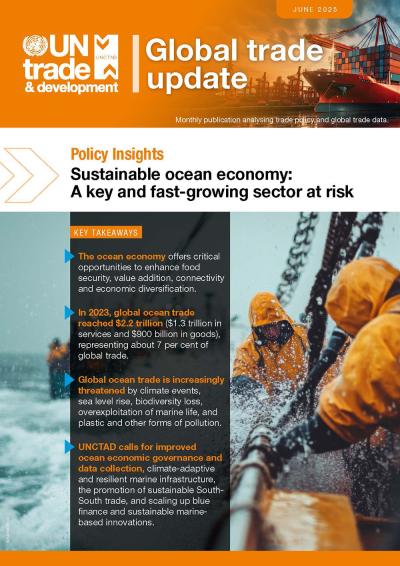
Between 1995 and 2020, the ocean economy grew 2.5 times, outpacing the 1.9-fold growth of the global economy. Developing countries drove much of this expansion.
About 600 million people rely on the ocean economy. It supports 100 million jobs, mainly in fisheries, aquaculture and tourism.
The sector offers a path to greater food security, value addition and economic diversification. But climate shocks, rising seas, pollution and biodiversity loss threaten its future.
UN Trade and Development (UNCTAD) calls for stronger ocean economic governance and better data collection. It also urges investment in climate-adaptive and resilient marine infrastructure, more South-South trade, and scaled-up blue finance and sustainable marine-based innovations.
Ocean trade tops $2.2 trillion, led by services
In 2023, global ocean trade reached $2.2 trillion – $1.3 trillion in services and $900 billion in goods. It made up about 7% of world trade.
Tourism led the way, generating $725 billion, or one third of all ocean trade. Other major sectors included maritime freight transport, ships and port equipment, and high-tech and manufactured goods, such as renewable energy, pharmaceuticals and electronics.
Most developed and developing economies (except China) reported surpluses in ocean services, mainly tourism, but deficits in goods. Small island developing states saw surpluses in both. Least developed countries, many with large coastlines, faced ocean trade gaps across the board.
Tariffs threaten fisheries exports
New United States tariffs on fisheries imports pose challenges for countries that depend on the US market. Mexico and Canada are the most exposed but can export duty-free under the United States-Mexico-Canada Agreement, if rules of origin are met. Products from these countries that don’t meet the rules of origin face a 25% tariff. For primary fisheries, compliance is simpler than for complex manufactured goods.
Aquaculture is on the rise
Overfished stocks and rising demand are shifting the sector from wild capture to aquaculture.
Since the 1990s, wild capture has held steady at about 90 million tonnes. Aquaculture, by contrast, has surged from 22 million to 94 million tonnes in 2022. It now accounts for over half of aquatic animal production and 57% of aquatic food consumed globally.
Demand is also growing for sustainable marine materials. Seaweed-based plastics and other non-fossil alternatives are gaining ground. These can help tackle pollution and open new export markets for coastal and island economies.
Finance falls short
Ocean-related aid reached just $2.4 billion in 2022 – far below what’s needed to meet global goals.
UN Trade and Development is calling for a $2.8 trillion “Blue Deal” to fund mangrove conservation and restoration, decarbonisation of shipping and fisheries, sustainable ocean-based production, and coastal and offshore wind energy.
Without urgent investment, the ocean economy risks falling short of its potential to deliver sustainable growth and achieve Sustainable Development Goal 14.






